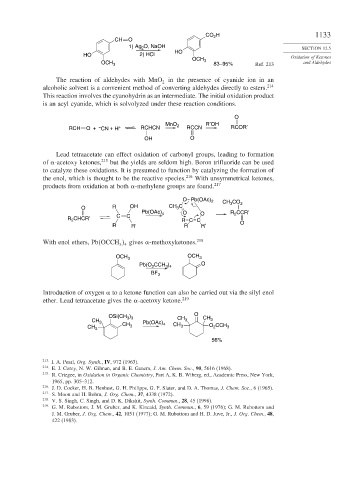Page 1157 - Advanced Organic Chemistry Part B - Reactions & Synthesis
P. 1157
CO H 1133
2
CH O
1) Ag O, NaOH SECTION 12.5
2
HO
HO 2) HCl Oxidation of Ketones
OCH
OCH 3 3 83–95% Ref. 213 and Aldehydes
The reaction of aldehydes with MnO in the presence of cyanide ion in an
2
alcoholic solvent is a convenient method of converting aldehydes directly to esters. 214
This reaction involves the cyanohydrin as an intermediate. The initial oxidation product
is an acyl cyanide, which is solvolyzed under these reaction conditions.
O
MnO 2 R′OH RCOR′
RCH O + – CN + H + RCHCN RCCN
OH O
Lead tetraacetate can effect oxidation of carbonyl groups, leading to formation
of -acetoxy ketones, 215 but the yields are seldom high. Boron trifluoride can be used
to catalyze these oxidations. It is presumed to function by catalyzing the formation of
the enol, which is thought to be the reactive species. 216 With unsymmetrical ketones,
products from oxidation at both -methylene groups are found. 217
O Pb(OAc) 2
CH 3 CO 2
O R OH CH 3 C
Pb(OAc) 4 O O R CCR′
2
R CHCR′ C C R C C
2
R R' R R′ O
With enol ethers, Pb OCCH gives -methoxyketones. 218
3 4
OCH 3 OCH 3
Pb(O CCH ) O
2
3 4
BF 3
Introduction of oxygen to a ketone function can also be carried out via the silyl enol
ether. Lead tetraacetate gives the -acetoxy ketone. 219
OSi(CH ) O CH
CH 3 3 3 Pb(OAc) CH 3 3
CH 3 CH 3 4 CH 3 O 2 CCH 3
56%
213 I. A. Pearl, Org. Synth., IV, 972 (1963).
214
E. J. Corey, N. W. Gilman, and B. E. Ganem, J. Am. Chem. Soc., 90, 5616 (1968).
215 R. Criegee, in Oxidation in Organic Chemistry, Part A, K. B. Wiberg, ed., Academic Press, New York,
1965, pp. 305–312.
216 J. D. Cocker, H. B. Henbest, G. H. Philipps, G. P. Slater, and D. A. Thomas, J. Chem. Soc., 6 (1965).
217
S. Moon and H. Bohm, J. Org. Chem., 37, 4338 (1972).
218 V. S. Singh, C. Singh, and D. K. Dikshit, Synth. Commun., 28, 45 (1998).
219
G. M. Rubottom, J. M. Gruber, and K. Kincaid, Synth. Commun., 6, 59 (1976); G. M. Rubottom and
J. M. Gruber, J. Org. Chem., 42, 1051 (1977); G. M. Rubottom and H. D. Juve, Jr., J. Org. Chem., 48,
422 (1983).

